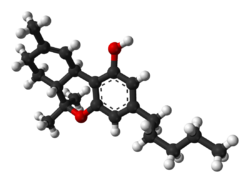
Back رباعي هيدرو كانابينول Arabic Тетрахидроканабинол Bulgarian টেট্রাহাইড্রোকানাবিনল Bengali/Bangla Tetrahidrokanabinol BS Tetrahidrocannabinol Catalan Tetrahydrokanabinol Czech Tetrahydrocannabinol Welsh Tetrahydrocannabinol Danish Tetrahydrocannabinol German Τετραϋδροκανναβινόλη Greek
 | |
 | |
| Clinical data | |
|---|---|
| Trade names | Marinol, Syndros |
| Other names | (6aR,10aR)-delta-9-Tetrahydrocannabinol; (−)-trans-Δ9-tetrahydrocannabinol |
| License data |
|
| Dependence liability | Physical: Low Psychological: Low–moderate |
| Addiction liability | Relatively low: 9%[citation needed] |
| Routes of administration | By mouth, transdermal, sublingual, inhalation |
| Drug class | Cannabinoid |
| ATC code | |
| Legal status | |
| Legal status |
|
| Pharmacokinetic data | |
| Bioavailability |
|
| Protein binding | 97–99%[3][4][5] |
| Metabolism | Mostly hepatic by CYP2C[3] |
| Elimination half-life | 1.6–59 h,[3] 25–36 h (orally administered dronabinol) |
| Excretion |
|
| Identifiers | |
| |
| CAS Number | |
| PubChem CID | |
| IUPHAR/BPS | |
| DrugBank | |
| ChemSpider | |
| UNII | |
| KEGG | |
| ChEBI | |
| ChEMBL | |
| CompTox Dashboard (EPA) | |
| ECHA InfoCard | 100.153.676 |
| Chemical and physical data | |
| Formula | C21H30O2 |
| Molar mass | 314.469 g·mol−1 |
| 3D model (JSmol) | |
| Specific rotation | −152° (ethanol) |
| Boiling point | 155–157 °C (311–315 °F) 0.05mmHg,[6] 157–160°C @ 0.05mmHg[7] |
| Solubility in water | 0.0028 mg/mL (23 °C)[8] |
| |
| |
| | |
Tetrahydrocannabinol (THC) is a cannabinoid found in cannabis.[9] It is the principal psychoactive constituent of Cannabis and one of at least 113 total cannabinoids identified on the plant. Although the chemical formula for THC (C21H30O2) describes multiple isomers,[10] the term THC usually refers to the delta-9-THC isomer with chemical name (−)-trans-Δ9-tetrahydrocannabinol. It is a colorless oil.
- ^ Anvisa (2023-07-24). "RDC Nº 804 - Listas de Substâncias Entorpecentes, Psicotrópicas, Precursoras e Outras sob Controle Especial" [Collegiate Board Resolution No. 804 – Lists of Narcotic, Psychotropic, Precursor, and Other Substances under Special Control] (in Brazilian Portuguese). Diário Oficial da União (published 2023-07-25). Archived from the original on 2023-08-27. Retrieved 2023-08-27.
- ^ "Marinol" (PDF). Food and Drug Administration. Archived from the original (PDF) on 2014-05-13. Retrieved 2014-03-14.
- ^ a b c d e Grotenhermen F (2003). "Pharmacokinetics and pharmacodynamics of cannabinoids". Clinical Pharmacokinetics. 42 (4): 327–60. doi:10.2165/00003088-200342040-00003. PMID 12648025. S2CID 25623600.
- ^ The Royal Pharmaceutical Society of Great Britain (2006). "Cannabis". In Sweetman SC (ed.). Martindale: The Complete Drug Reference: Single User (35th ed.). Pharmaceutical Press. ISBN 978-0-85369-703-9.[page needed]
- ^ "Tetrahydrocannabinol – Compound Summary". National Center for Biotechnology Information. PubChem. Archived from the original on 12 January 2014. Retrieved 12 January 2014.
Dronabinol has a large apparent volume of distribution, approximately 10 L/kg, because of its lipid solubility. The plasma protein binding of dronabinol and its metabolites is approximately 97%.
- ^ Gaoni Y, Mechoulam R (April 1964). "Isolation, Structure, and Partial Synthesis of an Active Constituent of Hashish". Journal of the American Chemical Society. 86 (8): 1646–47. Bibcode:1964JAChS..86.1646G. doi:10.1021/ja01062a046.
- ^ Adams R, Cain CK, McPhee WD, Wearn RB (August 1941). "Structure of Cannabidiol. XII. Isomerization to Tetrahydrocannabinols". Journal of the American Chemical Society. 63 (8): 2209–13. Bibcode:1941JAChS..63.2209A. doi:10.1021/ja01853a052.
- ^ Cite error: The named reference
Garrett1974was invoked but never defined (see the help page). - ^ Pichersky E, Raguso RA (November 2018). "Why do plants produce so many terpenoid compounds?". The New Phytologist. 220 (3): 692–702. Bibcode:2018NewPh.220..692P. doi:10.1111/nph.14178. hdl:2027.42/146372. PMID 27604856.
- ^ "THC Chemistry by Alexander Shulgin - January 21, 1995". www.druglibrary.org. Archived from the original on 2020-11-12. Retrieved 2020-11-12.
© MMXXIII Rich X Search. We shall prevail. All rights reserved. Rich X Search